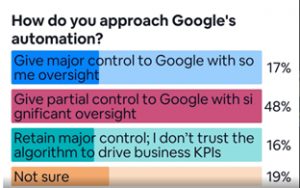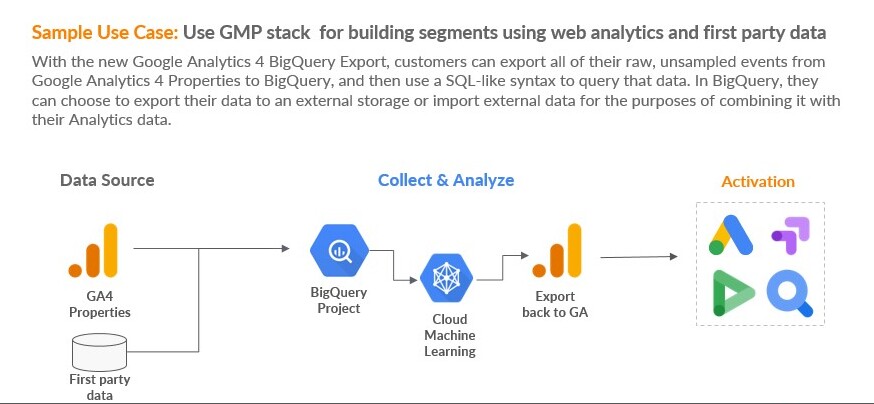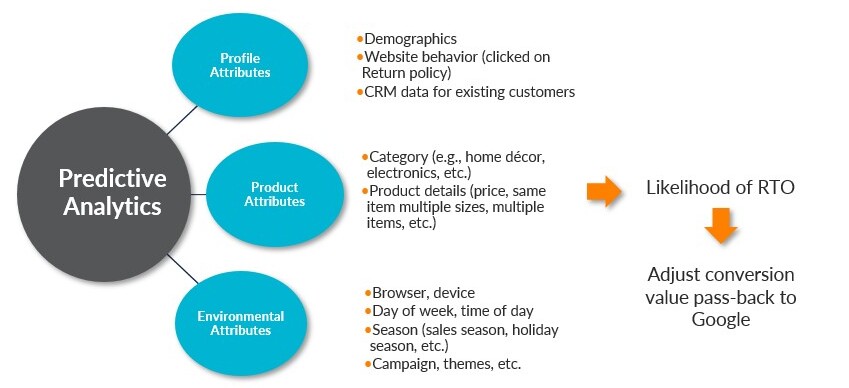How leading marketers are using Google Ads automation and data to supercharge growth
Is automation in Google Ads eating up the role of marketers? The answer is yes – but only the cumbersome, repetitive tasks, leaving marketers free to focus on strategic, high-value work. With Google automating routine tasks such as bid management, keyword research, ad creation, and optimization, marketers can now spend more time driving what matters most –the growth of their companies.
How can marketers leverage automation and analytics to close in on their business goals? In this thought paper, we outline what automation can and cannot do and identify five ways in which marketers add strategic value.
Evolution of Search Engine Marketing
Over time, the paid search channel has evolved significantly and become more sophisticated. In recent years, AI and improvements in machine learning have allowed Google to make great leaps in marketing automation. Since the introduction of responsive search ads (RSAs) in 2018, many advancements have been centered around automation, especially the adoption of automated bidding strategies and dynamic ad creatives.
With search becoming increasingly popular and complex, automation has enabled marketers to optimize campaigns at scale, freeing up their bandwidth and helping them focus on strategic tasks.
However, incremental automation has coincided with reduced signals and fewer controls. Some early search marketing platforms (such as Yahoo) operated an open auction model, allowing advertisers to see who was advertising and even what bids were set on specific keywords! Since then, multiple updates have layered on different elements of automation to help marketers manage their paid search activity — scripts, Dynamic Search Ads (DSAs), eCPC, and Smart Bidding, for example. The recently introduced “Performance Max” campaigns allow advertisers even lesser control over their targeting and performance data.
Figure 1: Paid search management has evolved with increased automation
Figure 2: Google has reduced signals and controls in paid search
Role of automation
Automation tools can help marketers move away from managing dozens of campaigns and instead focus on strategic areas of growth such as budget planning, keyword targeting, increasing audience engagement, and exploring new avenues that will benefit their sales funnels. It can also help them improve campaign performance and reduce wasted ad spending.
However, automation is not perfect yet!
Automation doesn’t mean campaign managers can ‘set it and forget it.’ Google is very good at launching fast or failing fast, as they say! Automation in paid search is still evolving and like a traditional AI approach, Google will leverage advertisers’ inputs to help teach the system. “Broad Match” is a great example of how a feature improved over time.
But Google’s automation has its limitations. For example, it’s not yet to be able to read seasonality perfectly, especially spikes during Black Friday or Christmas Sales. Short sales and offers too don’t always perform well as systems are not able to learn quickly enough. And when broad keywords are used with Smart Bidding, the automation still targets irrelevant keywords. Similarly, choosing to auto-apply Optiscore recommendations can lead to wrong keywords and poor ad copy recommendations.
Our poll shows that most marketers are aware of these limitations and maintain significant oversight over their campaigns.

Figure 3: iQuanti Poll showing the degree of control marketers like to retain over Google automation
Role of Marketers in the Age of Automation
Automation allows paid search practitioners to focus on strategic planning and execution while keeping business KPIs, profitability, and media mix in mind.
Data plays a critical role in the success of automated campaigns. Paid search marketers must ensure that the inputs – target keywords, ad-copies, audience targeting, etc. – are aligned with their business goals, and let the system know the direction they want to go with.
While ensuring that rich data such as customer lifetime value (LTV) gets fed into the system, marketers must also declutter to refine the performance through actions such as negative keywords and placements. They must keep one eye on performance and another on spending!
Marketers should always be in the know of their industry trends, macroeconomic factors, and competitive movements. Platforms can never substitute human intelligence but can certainly augment it.
Strategic role of a marketer
As automation takes over much of the tactical work that campaign managers used to do manually, they have an opportunity to focus on more strategic tasks, using data to drive their decisions. Here are five ways in which marketers can leverage automation and data to achieve their strategic goals:
A. Craft non-brand strategy using detailed analysis of competitive strengths and weaknesses
When building strategy, marketers typically just use a keyword planner tool like Google Keyword Planner or SEM Rush to create a keyword list for their non-brand campaign. There is often a business context lacking in this exercise. While, with ongoing optimization, over time they will understand what is working and what is not working, they will end up spending significant amounts to gather these learnings.
Marketers have an opportunity to bring business context to the keyword planning exercise. Advertisers can deep dive into the product and understand the product’s key competitive strengths and weaknesses and leverage these insights for keyword planning. This will not only help in selecting the right keywords with high potential for conversion but will also help right keyword theming and message personalization.
Use Case
Let’s say a marketer is managing a campaign for a leading credit card company, and they are bidding for cash-back credit cards. When they compare their product against the industry, they find out that there’s a strong gas cashback offer, but their brand is not competitive with groceries cashback. So, to build their non-brand strategy, they should know that keywords like cashback and credit cards for “gas” are advantage keywords where they have a comparative advantage, and then keywords around “groceries” where they have a disadvantage.
Marketers can leverage these insights for building ad copies. For instance, if they know that they have a very competitive gas offer against their competing brands, they can have messaging related to “gas rewards” in their ad copy when bidding against those brands.
Figure 4: Example of bringing business context to the keyword planning exercise
B. Devise tactics to enhance landing page experience and inform the A/B testing roadmap
While marketers are focused on optimizing media bids and budgets, they neglect to optimize experiences on landing pages. Optimizing and customizing landing pages can have a dramatic impact on campaign economics. But marketers typically leverage one or two landing pages across different campaigns and ad groups and there is often no ongoing testing and optimization.
Marketers typically use some web analytics data and sometimes A/B testing, but they’re usually ad hoc. Here are some simple yet effective tactics that can help marketers identify the gaps in the user experience and optimize it significantly.
- Run user testing to understand the reasons for gaps in user experience. Self-serve platforms like userlytics.com and usertesting.com make user testing fast and seamless.
- Do a competitive analysis for inspiration to build best-in-class experiences. Look at direct competitors as well as best-in-class players in and outside your industry.
- Leverage industry best practices from publications who have already tested experiences
C. Use advanced analytics and ML for building audience segments
Marketers have a lot of data about first-party audiences but they don’t always leverage them effectively. They often upload entire customer lists for cross-sell segments but fail to segment the data or to deploy negative targeting segments.
With AI/ML-based solutions becoming more common, marketers can maximize the potential of first-party data. The biggest use case is segmentation. Marketers can transition from a purely rules-based approach to an AI- and machine learning-based approach which enables more nuanced segmentation and better prioritization and personalization, improving overall marketing effectiveness.
Use case
When it comes to retargeting, marketers usually build segments based on pages or sections visited. But micro-interactions – the way users interact with the website – can give deep insights about their intent, need, and potential value. To leverage data from these micro-interactions, marketers can use GA4 and combine it with first party data and ML to build intelligence that can be activated across different platforms (see Figure 4). The ML and AI engines will do the work of matching the message, offer, and spend to a particular audience.
Figure 5: Building segments with web analytics and first party data
D. Use predictive analytics with smart bidding to optimize for business KPIs holistically
One of the limitations of smart bidding is it cannot optimize for events which have a significant time lag. Marketers typically set online conversion events – application approval, average order value, and so on – for smart bidding campaigns. However, these online conversion metrics do not reflect offline conversions that occur several weeks later or the additional revenue from these customers over time. This means that many marketers fail to optimize for these offline conversions or lifetime value (LTV) metrics.
Marketers can transition towards optimizing for holistic business KPIs by leveraging predictive analytics. They can look at different predictive analytics models to estimate the potential value of the customer at the time of the online conversion. Different profiles, products, and environmental attributes can help predict the potential value of customers – look at Figure 6 for examples of attributes. Marketers can pass this value back to Google with a target ROAS or maximize conversion value bidding strategy.
Figure 6: Example of predictive analytics model to optimize for business KPIs
Use Case
TROAS for deposits – Citi In e-commerce Return to Origin (RTO) – return of an order to the seller because it could not be delivered – can be as high as 50% for certain categories of products like clothing and shoes. Marketers can leverage attributes such as “users clicked on return policy”, gender, product category, number of products, variety of products (same product in different sizes), and holiday season, to predict the potential likelihood of RTO.
E. Contextualize performance by providing industry, consumer, and competitive insights and building a robust strategy
There are several external factors that influence campaign performance – industry trends, economic environment, and competitor tactics are some. Marketers do a lot of analysis around the impact of campaign optimizations on performance. However, there is a lack of understanding of the impact of external factors on performance.
Marketers should go beyond just the page search console and look at what’s happening in the industry, consumers’ needs and expectations, and what the competition is doing to contextualize performance.
Conclusion
As Google Ads automation evolves, the role of the marketer must evolve with it. Far from diminishing marketers’ role, increased automation makes human oversight and intervention even more vital for success. The marketers who are able to harness automation, data, and analytics synergistically will have an unbeatable competitive advantage in paid search









